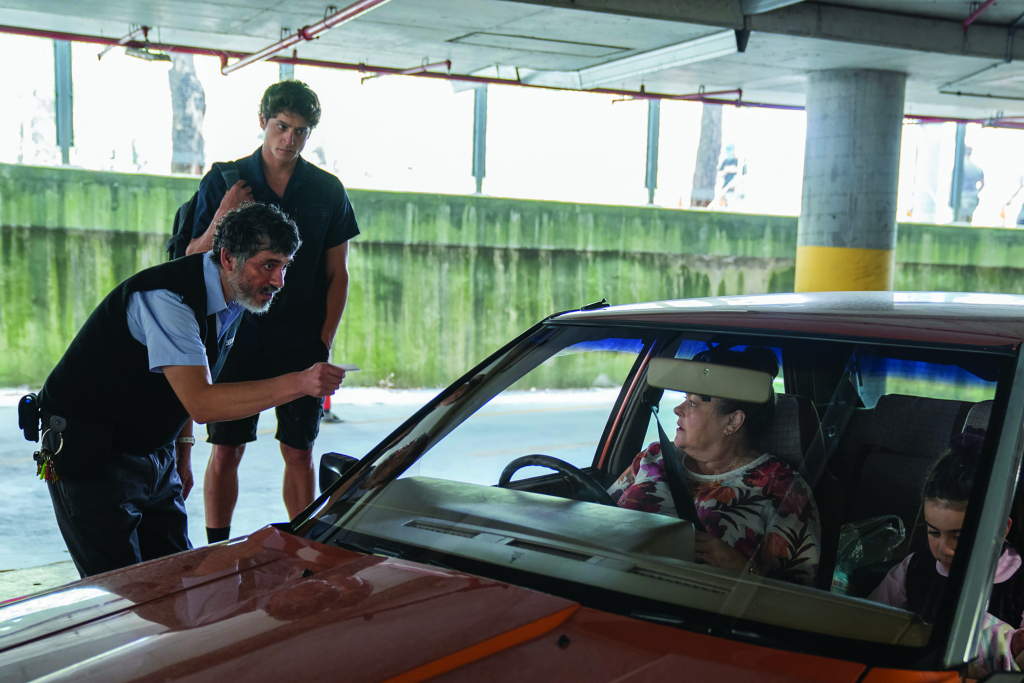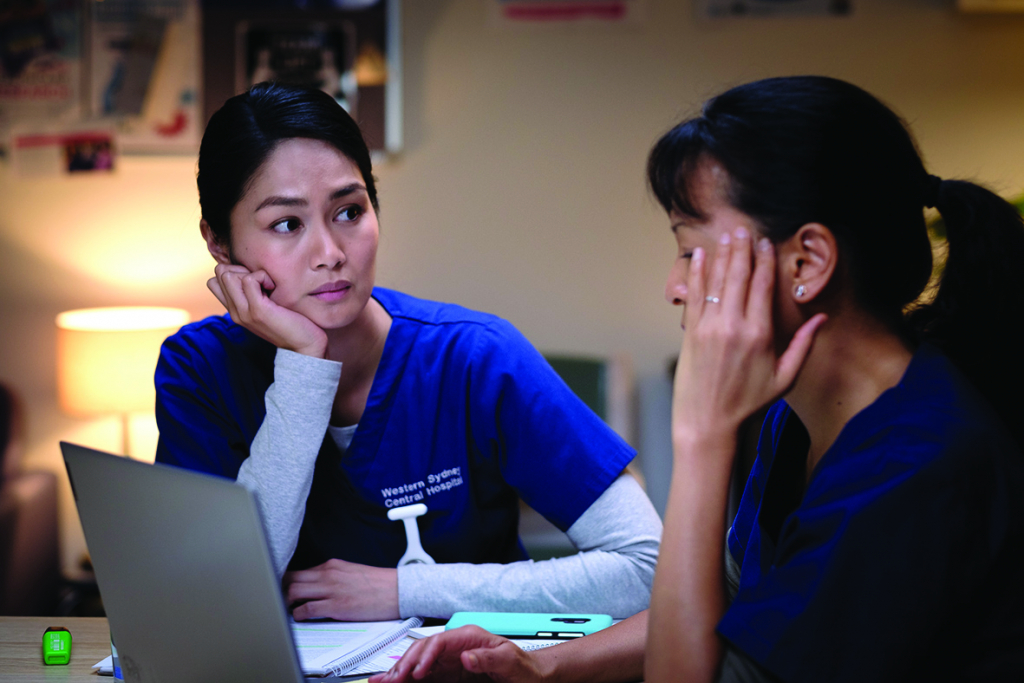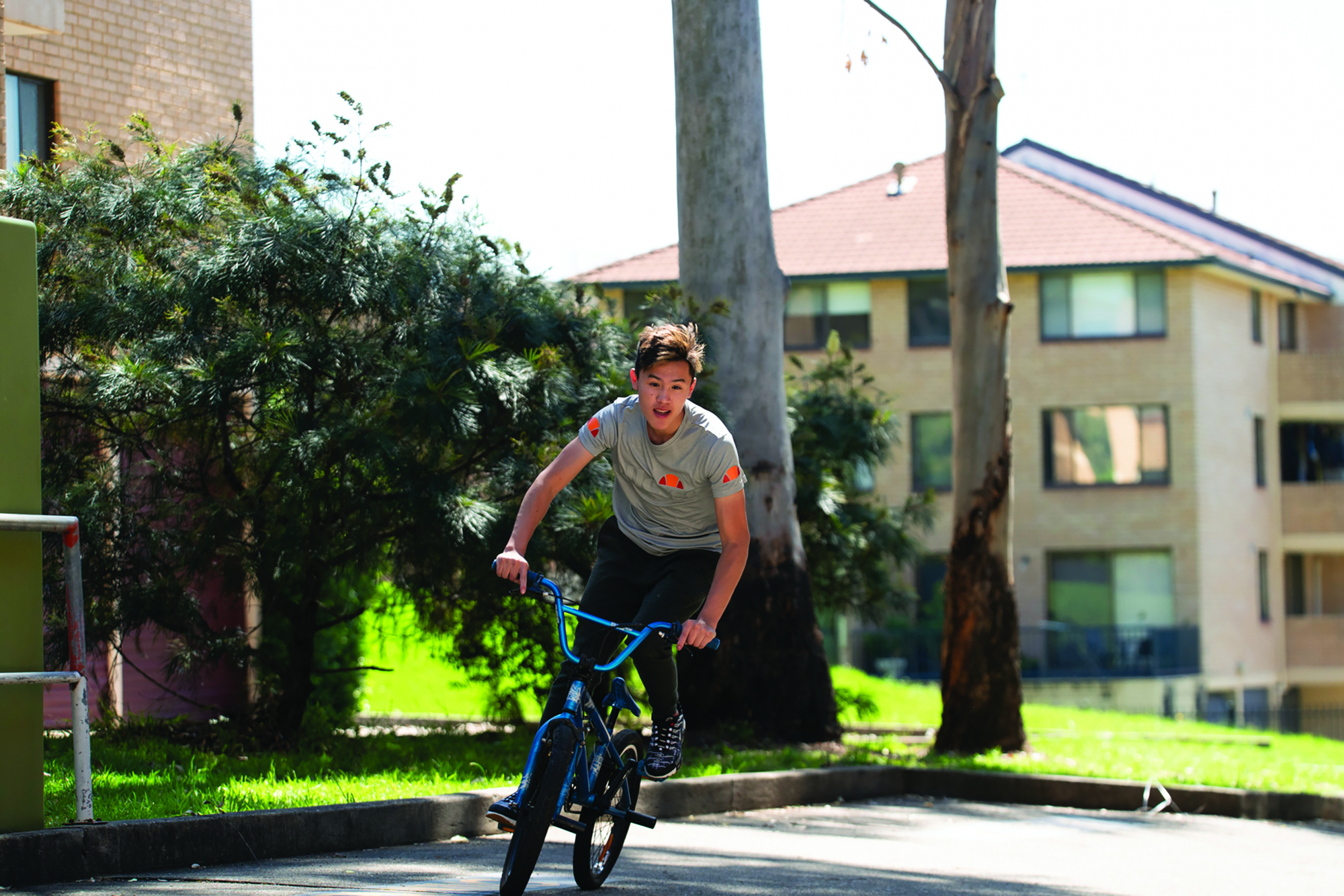An opportunity for eight emerging writers[1]The film’s stories are written by Nisrine Amine, Bina Bhattacharya, Matias Bolla, Claire Cao, Arka Das, Dee Dogan, Vonne Patiag and Tien Tran. to have their stories depicted by five established female filmmakers,[2]Kalceff and Kokkinos shared directorial responsibilities with Fadia Abboud, Lucy Gaffy and Leah Purcell. Here Out West (2022) breaks new ground with its depiction of interconnected character-driven narratives tied to the seldom-represented, culturally diverse region of Western Sydney.
I talk to two of its directors, Julie Kalceff and Ana Kokkinos, about bringing some of these narrative stories to life and the creative challenges of working on an anthology film.
Oliver Pfeiffer: What was appealing about Here Out West, and how did you become involved?
Julie Kalceff: Annabel Davis, the CEO of Co-Curious,[3]Established in 2018, Co-Curious is an arts company that collaborates with emerging writers from underrepresented backgrounds to help them develop industry careers. started the initiative to give a voice to undiscovered writers. They chose eight emerging writers and they each wrote a ten-minute [story], which were woven together into a feature by [script editor] Blake Ayshford […] Annabel approached me to direct one of the chapters, and so I had the pleasure of reading all the scripts.
What really drew me to the project was that it was a great initiative which gave these writers from Western Sydney an opportunity to get a screen credit […] I grew up in Western Sydney, and back then I saw very little representation on screen. So it was refreshing to read these stories with authentic voices that were about different communities in the place [where] I grew up.
Ana Kokkinos: The producers approached me to see whether I would be interested in working on a chapter film. I read the script and found the stories very poignant […] I also really responded to the diverse nature of what the stories were about, how they were constructed and [how] this was because they came from very diverse backgrounds.
Part of the initial process for all of us was choosing chapters that we wanted to direct. I was very drawn to ‘Everything Changes’ and ‘The Eternal Dance’, and other directors were drawn to other chapters. So it kind of came together when we chose chapters that we had a connection to.
The other unique thing about the project was that it was set in Western Sydney, which is a part of Sydney [where] I’d spent some time, and the kind of people that inhabit it I find really quite fascinating.
Julie, why were you attracted to ‘The Long Shift’ over the other stories?
JK: I was particularly drawn to ‘The Long Shift’, written by Vonne Patiag, because there was a real sense of family in that story – there’s the nurses who come together and bond as a family. The lead character, Roxanne (Christine Milo), is [geographically] separated from her husband and her child, so she’s had to find her family. I’m a lesbian and part of the LGBT community, so that idea […] of a ‘found family’ is a really important part of my life.
We see Roxanne in other chapters but in the background, because in a lot of stories someone like her, a nurse, is a background character. What was important for me was putting her front and centre and really getting to know the work that these people do and the sacrifices that they make. One of the things I thought was interesting was the place that women have in society, and the pink-collar workers who are usually in the background and carry the emotional load [but don’t] get recognised for it.

Ana, you directed ‘Everything Changes’, ‘The Eternal Dance’ and co-directed ‘Brother Tom’. Why did these stories appeal to you?
AK: I really liked ‘Everything Changes’ because, in a way, it reminded me of my own father. I also had a strong connection to a lot of Chilean friends. That migration certainly happened post–[Augusto] Pinochet coming to power, where there was a big influx [into Australia] of political refugees from Chile post-1973. So I felt I knew what [writer] Matias [Bolla] was trying to speak about, which is that often migrants come to this country […] from intellectual or creative backgrounds, but they’re not recognised as being middle-class or intelligent or professionals in any way. They come here with no [English] and are reduced to working in jobs that they are overqualified for. I think that’s a very common thing that has happened here with migrants who can’t find their footing in the way they did back home. I found that a really poignant story, personally.
With ‘The Eternal Dance’, I loved the central idea, which is that a Bengali daughter cannot communicate with her father because she doesn’t know the language. That simple idea really attracted me because, in the end, by being able to find her voice, she also connects with her own cultural background in a way that has meaning, at the moment of her father’s passing – but, in doing so, she kind of honours her culture in a very profound way.
My involvement with ‘Brother Tom’ was a little accidental,[4]Kokkinos took over directing duties from Abboud on ‘Brother Tom’ due to an undisclosed ‘accident’ during filming. but I also found the story incredibly poignant. [It revolves] around this sort of aspirational Vietnamese guy feeling like he’s being accepted by the Anglo culture and his younger brother kind of saying, ‘You think you’ve made it, but actually they’re all laughing behind your back.’ I also found great poignancy in the way in which the father reminds his older son about what it means to be proud of who you are.

Tell me a bit about the collaborative process of working on an anthology film. Did you get together as directors to discuss your approaches? Was there some discussion about your individual styles and how your stories would cross over?
JK: We had time during pre-production where [we all] sat down and spoke about the tone [and] the overall style, which we did in conjunction with the cinematographer, Tania Lambert. What the producers did as well, which was really smart, was they had the same heads of department across the entire film. So while there were five different directors, eight different writers and eight different stories, there […] was consistency of look and of tone […] while we each brought our own individual style.
AK: We talked a lot about tone, feel, the look of it and how to find ways to have a similar approach in terms of the way we shot it, which we decided would be primarily handheld. We also agreed that we wanted to create a sense of intimacy between the camera and the characters. We felt that […] in terms of the lighting [we wanted it] to be as natural as possible, but at the same time to give it a heightened quality.
It’s customary in anthology films for elements of individual episodes to cross over into other stories, and here it’s done quite seamlessly. In ‘The Eternal Dance’, for instance, Robi (Arka Das) from ‘Brotherhood’ assists the daughter of a dying father. How did this work from a practical perspective? Were there any moments where you had multiple directors working on different stories on set, for example?
AK: We did. Leah [Purcell] and I tried to ensure that the crossover on a script level worked for ‘Brotherhood’ and also worked for ‘The Eternal Dance’. We certainly collaborated on that, and there was a day when we had crossover in terms of both of us being on set: she needed to complete one section of filming where there was some overlap […] and vice versa, so we collaborated to ensure those crossovers would work for the film and for each chapter.
I guess one of the challenges was having a relatively short timeframe to develop your lead characters. Was there fear that the audience would want to linger with a character longer, and was this hard to overcome due to the film’s fragmented nature?
JK: Yes, there was some discussion about how we would make that work. On average, you have ten minutes with each character […] I tried to solve that problem [in my segment by ensuring that] Roxanne is the first person we see and [following her] the whole time. Therefore, we know it’s her story, and build a relationship with the character.
AK: I think some of those stories were capable of being bigger stories […] It would’ve been great to linger a little bit more on certain characters and linger a bit more in terms of perhaps where one of the stories could’ve gone. But, in the end, I think that was the choice that was made by the producers and the way they wanted to tell those stories.

Was there much that had to be cut out from what was originally shot due to time constraints?
AK: It was low-budget filmmaking, so we didn’t really have the luxury of shooting a whole lot and saying, ‘We have all this footage; what shall we do with it?’ Those very tight budget constraints meant we’d roughly got ten minutes to tell the story. The genesis of the project was about these eight talented writers who come from very different backgrounds [and] who wanted to write stories that said something about their lived experience. It wasn’t to then create it into, perhaps, a different film narrative where one or two stories dominated the whole thing.
Another constraint, which was a positive, was that the writers were given the space to collaborate with us, to ensure that their culturally specific elements within their story were going to be honoured. So it was a process with the writers where they learned what it means to say, ‘I’ve written this short story or short film; how is it now going to be executed in a way that is meaningful for an audience, but also meaningful for the characters and the culture that they represent?’
‘When I made Head On, I remember thinking that would unleash another burst of films from filmmakers who didn’t come from Anglo backgrounds … That largely didn’t happen.’
– Ana Kokkinos
What will you take away from your experience on Here Out West?
JK: As a writer myself, it’s the model that Co-Curious has set up, where the writers are in power from day one so [that] those stories and their voices are protected throughout. Not many production companies do that. What Co-Curious and Emerald Productions have done in this instance is they have really made an effort to keep the writers involved and [let them] be part of the process. [The writers] know the story better than anyone, so it makes sense to keep them involved.
AK: I’m really glad I was part of the experience. I felt there was great humanity in these stories, and I was thrilled to see big communities being represented, particularly Western Sydney. My desire to be involved with it was to help continue to promote diversity on our screens. I believe wholeheartedly that if we don’t, we are denying ourselves as a culture different perspectives, different voices, different languages which enrich our experience of who we are.
When I made Head On (1998), I remember thinking that would unleash another burst of films from filmmakers who didn’t come from Anglo backgrounds, and we would see more queer films and more films that expressed different points of view that came outside the mainstream. That largely didn’t happen; so, whenever there’s an opportunity to reignite that question again and allow it to be seen by a more mainstream audience, then I want to be a part of it.
Endnotes
| 1 | The film’s stories are written by Nisrine Amine, Bina Bhattacharya, Matias Bolla, Claire Cao, Arka Das, Dee Dogan, Vonne Patiag and Tien Tran. |
|---|---|
| 2 | Kalceff and Kokkinos shared directorial responsibilities with Fadia Abboud, Lucy Gaffy and Leah Purcell. |
| 3 | Established in 2018, Co-Curious is an arts company that collaborates with emerging writers from underrepresented backgrounds to help them develop industry careers. |
| 4 | Kokkinos took over directing duties from Abboud on ‘Brother Tom’ due to an undisclosed ‘accident’ during filming. |





